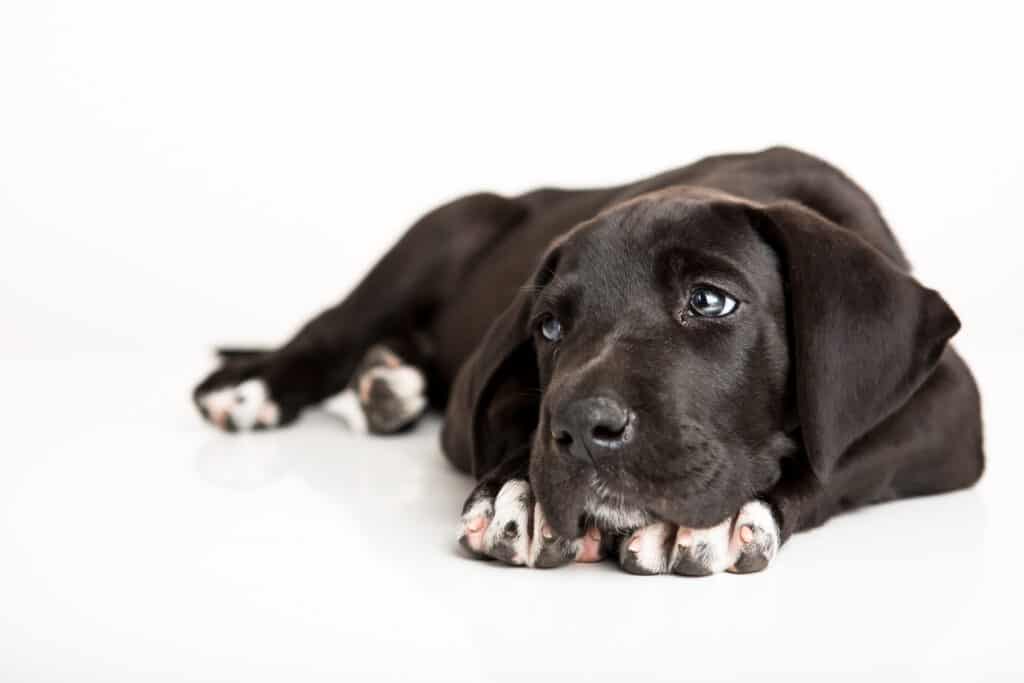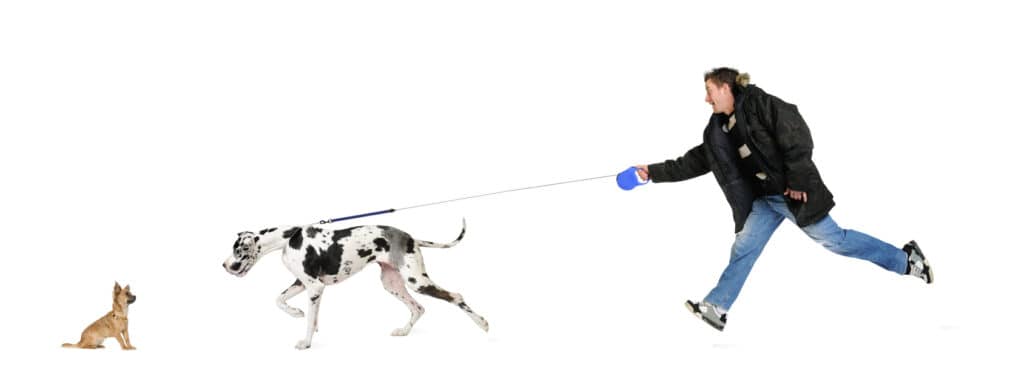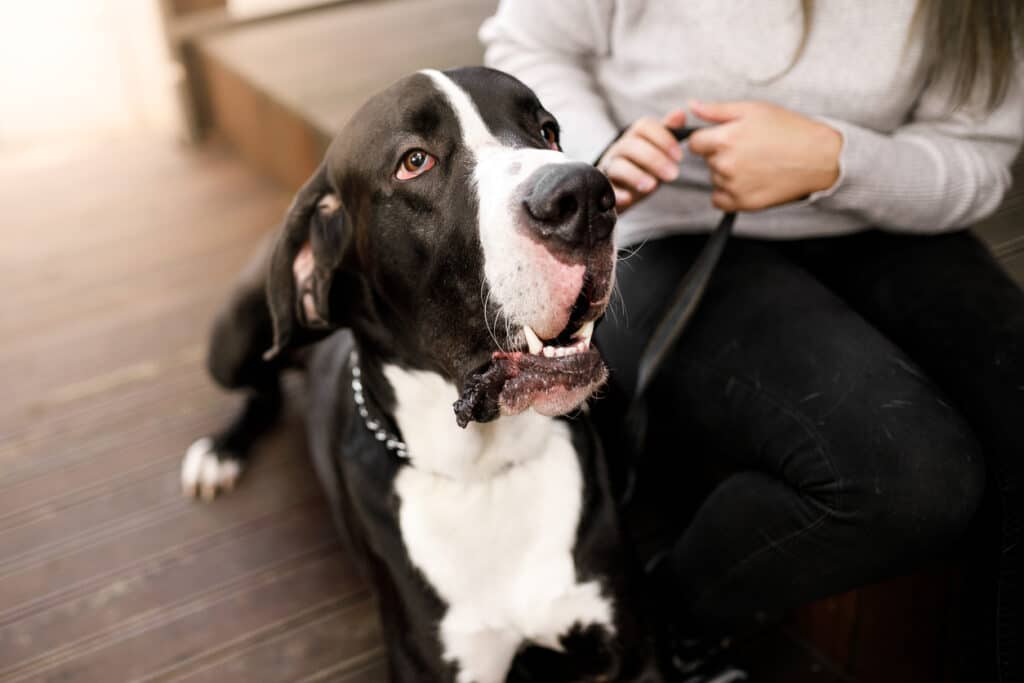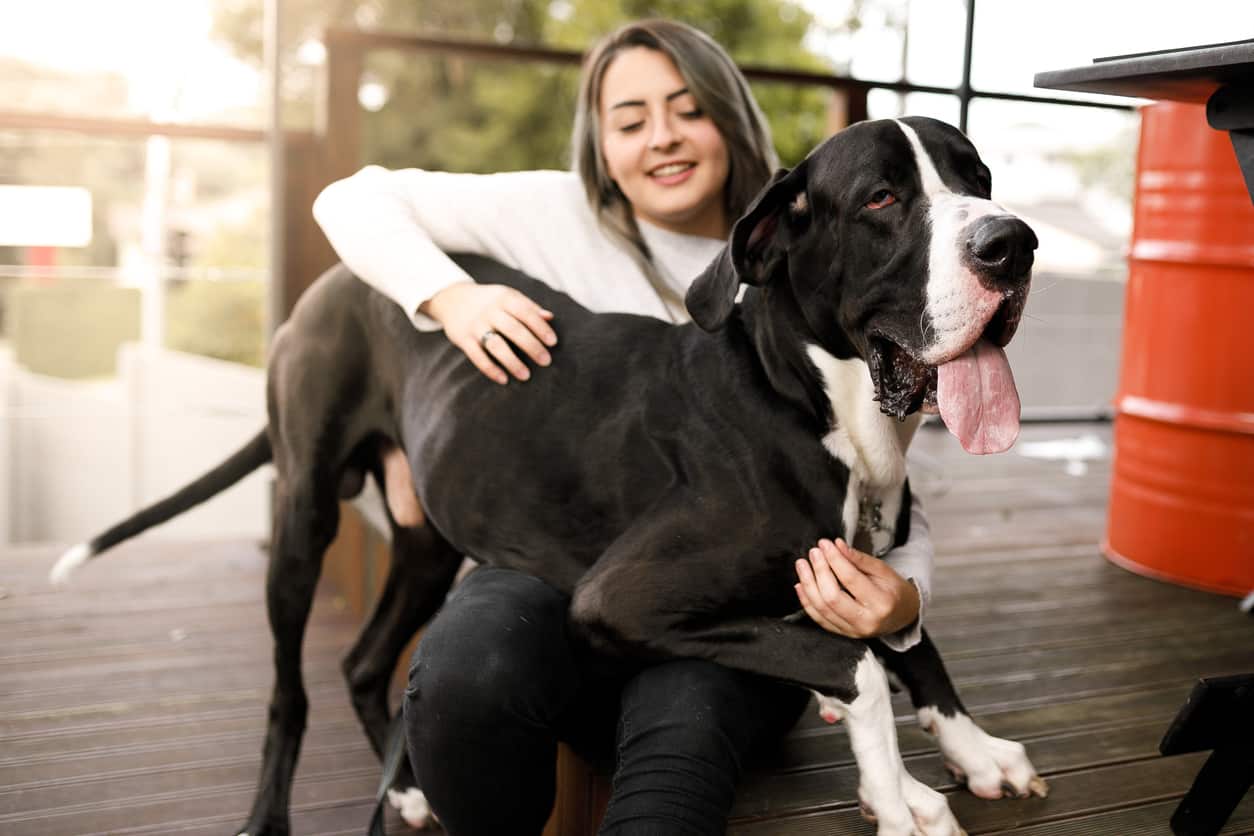Great Danes are one of the most popular dog breeds in the United States. Renowned for their affectionate, loyal, and protective dispositions, these dogs make wonderful pets for both individuals and families. They are, of course, also known for their great size, which is a trademark characteristic of the breed in the same way that spots are for a Dalmatian or a long golden coat is for a Golden Retriever. Unfortunately, unlike spots or longer fur, a Great Dane’s height directly contributes to the many health issues that tend to afflict the breed. All of this considered, you may be wondering what the health issues of a Great Dane include.

The most common health issues for Great Danes are bloat, hip dysplasia, Wobbler’s syndrome, and allergies.
A Great Dane’s height is part of its confirmation. Confirmation refers to the physical structure of an animal, and the terminology is most often deployed by breeders, people who show their dogs, and judges. However, it’s a good word for any prospective Great Dane owner to add to their vocabulary to the outsize influence a Great Dane’s confirmation has on its overall health. For example, Great Danes tend to have narrow, deep chests. This puts them at risk of bloat, which is in fact one of the most serious illnesses the breed can contract.
Great Dane Health issue #1: Bloat

Bloat is the simplified term for Gastric Dilatation-Volvulus (GDV). GDV is an extremely painful, always life-threatening condition that occurs when too much air or gas fills the stomach and becomes trapped. There are various ways that the stomach can be filled with too much air, such as by “gulping” air or water or otherwise breathing unevenly. This results in a distended abdomen that will become painful to the touch as the condition worsens.
After the air or gas becomes trapped, the stomach quickly begins to press up on other organs. The pressure caused by the buildup may cause the stomach to twist, and this twisting is known as torsion. When this happens, the likelihood of death increases dramatically because blood flow is effectively cut off and it’s inevitable that the dog will go into shock and die.
In the case of bloat, veterinary intervention is crucial from the moment you suspect your Great Dane may be bloating – it is simply impossible to know whether the animal’s body will be able to expel the trapped air. The exact cause of bloat is unknown, but several factors linked the development of the condition such as being a large or giant breed, genetics, and eating too quickly, describe Great Danes to a T.
There are several things you can do in order to minimize your Great Dane’s risk of bloat. The first thing you can do before you even choose a Great Dane puppy to bring home – talk with your breeder. A good breeder will be able to tell you if there are any immediate relatives with bloat in the puppy’s bloodline. They will also be proactive about socializing their Great Dane puppies to be courageous and inquisitive from the moment they’re born. This is important because the more temperamentally even a dog is, the less likely it seems to be that they develop bloat. Finally, when you bring your Great Dane puppy home, creating and following a carefully planned feeding schedule (perhaps exploring whether raised feeders are an option for you) and regulating the amount of exercise your Great Dane gets prior to and after eating are factors in your control to minimize the risk of bloat.
Bloat can be unpredictable, which is why it’s such a frightening condition. Having a plan in place can help you feel more prepared to deal with the issue should it arise. Consult with your veterinarian on what the best response plan to a suspected case of bloat would be for you.
Great Dane Health issue #2: Wobbler’s syndrome

Wobbler’s syndrome is a neck disease that commonly occurs in large and giant dog breeds. As a breed, Great Danes are slightly more than 4% likely to deelop this condition, and the majority of these cases occur in Danes three and younger. The concentration of the condition in younger Danes speaks to its connection to the extended growth phase Great Danes undergo. This, in turn, makes it very important for Great Dane owners to educate themselves on how to properly raise their Great Dane through the growth phase. Falling short in this obligation could result in costly and avoidable health issues such as Wobbler’s Syndrome.
The disease is caused when the spinal cord and spinal nerve roots become compressed, resulting in neck pain, problems with the nervous system, and an unnatural wobbling gait, from which the syndrome derives its name. The syndrome itself is not actually one specific issue. Rather, it is the term for the confluence of problems that arise when issues happen with the spinal cord and neck. One of the more common technical terms you may hear to describe Wobbler’s Syndrome is cervical spondylomyelopathy (CSM). This is also called cervical vertebral instability (CVI) and cervical vertebral malformation (CVM). If your Great Dane develops this condition, it will possibly require an expensive corrective surgery, and it will definitely require medical treatment throughout the rest of its life.
The most important factor in controlling the pressure placed on your young Great Dane’s skeletal frame is its speed of growth. Great Danes should be fed on a schedule and with quality food that promotes a slow and steady rate of growth. Doing so will give the skeletal frame, bones, and joints time to strengthen naturally and fully.
Even the most carefully laid plans be bulldozed by a condition determined to manifest. When it comes to Wobbler’s Syndrome, the warning symptom typically begins in the back legs and causes the dog to splay its legs wide while standing or walking. If you notice that your Great Dane is starting to look weak in its back end and is otherwise healthy, make an appointment with your veterinarian immediately. Your vet will be able to run tests and help discern the problem.
If the problem is not addresses and your Great Dane continues to live with undiagnosed Wobbler’s Syndrome, the syndrome will make it difficult to stand and walk on slippery floors and to turn. Their front legs will eventually become affects and their gait will be completely changed. Instead of the smooth, loping movements you would expect to see in a Great Dane, it will begin to take shorter steps and its gait will be choppy. As the syndrome worsens, so does the prognosis, and the result is always debilitating for the animal.
Great Dane Health issue #3: Hip and elbow dysplasia
Like the first two health issues facing Great Danes, hip and elbow dysplasia is a concern largely due to the breed’s enormous size. Hip and elbow dysplasia are essentially deformities that occur at the hip or elbow joint. The hip joint functions as similarly to a ball and socket in a dog. The ball, which is the head of the femur, is located at the top of the long thigh bone (femur). In a healthy Great Dane, the ball rests inside the hip bone’s socket. Issues arise when the ball is not in its proper place.
Large dog breeds are particularly susceptible to these issues due to their huge size, which is why it’s important for Great Dane owners to be proactive about monitoring the speed at which their Great Dane puppy grows. A properly developed Great Dane puppy will require a special diet rich in calcium, phosphorous, and protein, with meals spaced out at small intervals throughout the day. A proper diet is a proactive way to mitigate the inherent risk in a Great Dane’s genetics, in which many issues such as hip dysplasia are hereditary. In addition to Great Danes, Labrador Retrievers and German Shepherds are also highly at risk for this condition, in addition to other breeds.
Hip and elbow dysplasia typically develops early in life or later in life. When an older dog develops the condition, it is typically in connection with osteoarthritis. If your Great Dane is at any point showing decreased activity or decreased range of motion, including difficulty or reluctance to place pressure on its joints (move), then it could be in the early stages of hip dysplasia. Eventually, these symptoms will worsen, but a veterinarian can intercede with medical attention and treatment for the dog that will make it more comfortable and extend its quality of life.
Great Dane Health issue #4: Allergies
Canine allergies manifest slightly differently than they do in humans. In humans, it’s typical for standard allergens such as pollen, mold, or dust to make us sneeze and experience itchy eyes. While dogs are also sensitive to these allergens, they express their allergy symptoms by itching rather than sneezing. This skin allergy is called “atopy” and is particularly common in Great Danes. Atopy affects the feet, belly, folds of the skin, and ears. A Great Dane may begin expressing seasonal symptoms as early as one year of age, and they can get worse each year.
If your Great Dane is suffering from atopy, they may lick their paws, rub their face, and develop frequent ear infections as a result of the buildup of allergens in the canal.
Fortunately, there are many treatment options available, but because the Great Dane is so large, it’s important for owners to vigilant from the beginning. As with any large or giant breed, small issues can quickly become magnified when it comes to addressing the health needs of a Great Dane.
When it comes to managing symptoms, you can approach this the same way you would for yourself. Minimize exposure to allergens and do your best to keep the home allergen free by upping the ante on vacuuming and cleaning throughout the duration of allergy season, as well as avoiding leaving windows open. Ensure to groom your Great Dane regularly, including cleaning its ears and clipping its nails. You can also consult with your veterinarian for additional tips if your Great Dane suffers from severe allergies.
Great Danes make wonderful family pets, but they do have certain health issues to be mindful of. While many people are aware that bringing a puppy into their home is a financial investment, it should be emphasized that bringing a Great Dane into your home is a significant financial investment. Even if you perform all due diligence and are emotionally prepared to care for your Great Dane throughout the ups and downs of life, you should bear in mind that the average cost of owning a Great Dane for their average lifespan (7-10 years) is around $20,000, with much potential for variability depending on simple luck.


